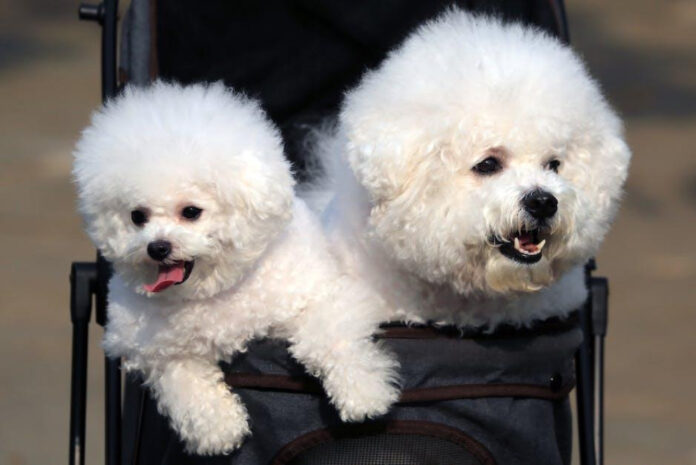The origin of the poodle is a subject of longstanding debate, with various theories and historical evidence contributing to the dog breed’s mysterious and enigmatic past. In this article, we will delve into the origins of the poodle, examining the various historical accounts and genetic evidence to shed light on the fascinating and complex history of this beloved canine companion. By analyzing the breed’s documented history and genetic ancestry, we aim to provide a comprehensive understanding of the poodle’s origins and how it has evolved into the beloved breed we know today.
Table of Contents
- Origins of the Poodle Breed
- Historical Influences on Poodle Development
- Distinctive Characteristics of the Poodle
- Poodle Breeding Standards and Practices
- Modern Challenges in Preserving Poodle Lineage
- Q&A
- To Wrap It Up
Origins of the Poodle Breed
The Poodle breed is widely regarded as one of the most iconic and recognizable dog breeds in the world, known for their intelligence, elegance, and versatility. Despite their popularity, the origins of the Poodle are shrouded in mystery and controversy. While the breed is commonly associated with France, the exact origins of the Poodle are still a subject of debate among historians and dog enthusiasts.
One popular theory suggests that the Poodle originated in Germany, where they were used as water retrievers. The word “Poodle” is thought to have derived from the German word “Pudel,” which means “to splash in water.” The breed’s distinctive curly coat is believed to have evolved as a practical feature to help protect the dog’s body and joints from the cold and harsh conditions of the water. Additionally, the Poodle’s exceptional swimming abilities and keen intelligence made them valuable assets to hunters in retrieving waterfowl.
Another theory proposes that the Poodle may have originated in France, where they were favored as companions of nobility and were often depicted in famous paintings and artwork. This theory suggests that the Poodle was selectively bred for their elegant appearance and hypoallergenic coat, making them popular among the French aristocracy. Regardless of their exact origins, the Poodle’s unique combination of intelligence, athleticism, and grace has secured their place as a beloved breed around the world.
**Key Points of Poodle Breed Origins:**
– Controversy surrounds the exact
– The breed was possibly used as water retrievers in Germany
– The Poodle gained popularity as a companion for French nobility
Historical Influences on Poodle Development
The development of the poodle breed has been greatly influenced by its historical roots. Dating back to the 15th century in Germany, the poodle was originally bred as a water retriever. This early purpose has had a lasting impact on the breed’s physical characteristics and temperament. The poodle’s impressive swimming abilities and high intelligence were cultivated through careful breeding over the centuries.
In addition to its German origins, the poodle also gained popularity in France, where it became known as the “Caniche” or “duck dog.” This French influence further shaped the poodle’s development, leading to the distinctive grooming styles associated with the breed today. The elaborate hairstyles were originally designed to help the poodle move more efficiently in water while still protecting vital organs and joints from the cold. These historical influences continue to be reflected in the poodle’s appearance and behavior, making it a truly unique and fascinating breed with a rich heritage.
**Key Influences on Poodle Development:**
– German origins as a water retriever
– French influence and the evolution of distinctive grooming styles
– Adaptation of physical characteristics and temperament for water retrieval
– Enduring legacy of historical influences in the modern poodle breed
| |
| —————————————– |
| **Origin:** Germany and France |
| **Purpose:** Water retrieval |
| **Grooming:** Distinctive styles |
| **Legacy:** Enduring impact on breed |
Distinctive Characteristics of the Poodle
The Poodle is a breed of dog with distinctive characteristics that set it apart from other breeds. One of the most notable features of the Poodle is its hypoallergenic coat, which makes it a popular choice for individuals with allergies. This unique coat also comes in three different varieties – standard, miniature, and toy – allowing for a range of sizes within the breed.
In addition to their coat, Poodles are known for their high intelligence and trainability. They are quick learners and excel in obedience training, making them a popular choice for various dog sports and competitions. The breed is also highly adaptable and can thrive in a variety of living situations, making them a versatile pet for individuals and families alike.
Poodles are also recognized for their distinct appearance, with their curly, non-shedding coat and elegant build. Their unique look has made them a popular choice for dog shows and competitions, where their striking appearance often earns them top honors. Overall, the Poodle’s hypoallergenic coat, intelligence, and distinctive appearance are just a few of the characteristics that make this breed stand out among the rest.
| Poodle Coat Varieties | Standard, Miniature, Toy |
| Trainability | Highly intelligent and quick learners |
| Adaptability | Thrives in various living situations |
Poodle Breeding Standards and Practices
Poodles are known for being one of the most elegant and intelligent dog breeds, but their origins may surprise some people. The breed actually originated in Germany, where they were used as water retrievers for hunting. Their distinctive curly coat and athletic build made them well suited for swimming and retrieving game from the water. The breed eventually made its way to France, where it was further refined and became popular among French nobility.
In terms of breeding standards and practices, it’s important to consider the historical context of the poodle’s origins. Breeders should prioritize maintaining the breed’s original traits, including their athleticism, intelligence, and elegant appearance. When breeding poodles, it’s also crucial to prioritize health and temperament to ensure the continued well-being of the breed. Responsible breeders should also focus on maintaining the standard size variations of poodles, including toy, miniature, and standard sizes. Additionally, ethical breeding practices should prioritize genetic diversity to minimize the risk of inherited health issues and ensure the long-term sustainability of the breed.
Overall, understanding the origins of the poodle breed is crucial for maintaining breeding standards and practices. By prioritizing the breed’s historical characteristics and focusing on health and temperament, breeders can ensure the continued success and well-being of this beloved dog breed.
Modern Challenges in Preserving Poodle Lineage
The Legacy of Poodles Origin
The origin of poodles is a topic of interest for many dog enthusiasts and breeders. These intelligent and elegant dogs have a rich history that dates back to several centuries. Poodles are believed to have originated in Germany, where they were used as water retrievers and skilled hunting companions. Their distinct hairstyles were actually functional, as the decorative clips and cuts helped the poodles move through water more efficiently while still providing protection for vital organs and joints.
Despite their long history, the are becoming increasingly apparent. These challenges include genetic diversity, breed standards, and health concerns. It is essential for poodle breeders and organizations to address these challenges in order to maintain the integrity of the breed and ensure their long-term well-being.
Genetic Diversity:
One of the main challenges in preserving poodle lineage is maintaining genetic diversity within the breed. Inbreeding and a limited gene pool can lead to various health issues and decreased overall vitality. Breeders must carefully select mating pairs to promote genetic diversity and reduce the risk of hereditary health problems.
Breed Standards:
Another challenge is the evolving breed standards for poodles. As with any purebred dog, there is a constant debate and adjustment to breed standards, which can sometimes lead to a shift in the appearance and temperament of the dogs. It is crucial for breeders to adhere to the original breed standards while also ensuring the health and well-being of the poodles.
In conclusion, while may pose significant obstacles, they can be addressed through careful breeding practices, genetic testing, and a commitment to preserving the heritage of these remarkable dogs. By maintaining genetic diversity and adhering to established breed standards, poodle enthusiasts can work together to ensure that these beloved dogs continue to thrive for generations to come.
Q&A
Q: Where do poodles originate from?
A: Poodles are believed to have originated in Germany, where they were bred as water retrieving dogs.
Q: What was the original purpose of poodles?
A: Poodles were originally bred to be water retrievers, often used for duck hunting. Their curly coat and webbed feet made them efficient swimmers, and their intelligence and trainability made them excellent at their job.
Q: Are there different sizes of poodles?
A: Yes, poodles come in three different sizes: standard, miniature, and toy. The standard poodle was originally bred for hunting, while the miniature and toy poodles were primarily kept as companions.
Q: When did poodles become popular as show dogs and pets?
A: Poodles gained popularity as show dogs and pets in the 20th century. Their elegant appearance, intelligence, and hypoallergenic coat made them popular among dog enthusiasts and families.
Q: Are poodles considered to be a hypoallergenic breed?
A: Yes, poodles are often considered to be hypoallergenic because they do not shed as much as other dog breeds. This makes them a popular choice for people with allergies.
Q: What is the lifespan of a poodle?
A: The average lifespan of a poodle is around 12-15 years, although this can vary depending on the size and health of the individual dog. Proper care, nutrition, and regular veterinary check-ups can help extend a poodle’s lifespan.
To Wrap It Up
In conclusion, the origin of poodles is a subject of historical significance and rich cultural heritage. The breed’s development from a hunting dog to a beloved companion animal is a testament to their intelligence, versatility, and adaptability. Understanding the origins of poodles provides valuable insight into their breed characteristics and behavior. By studying their history, we can better appreciate and care for these remarkable dogs. The legacy of the poodle stands as a testament to the enduring bond between humans and canines, and their place in our lives as loyal and cherished companions.

































